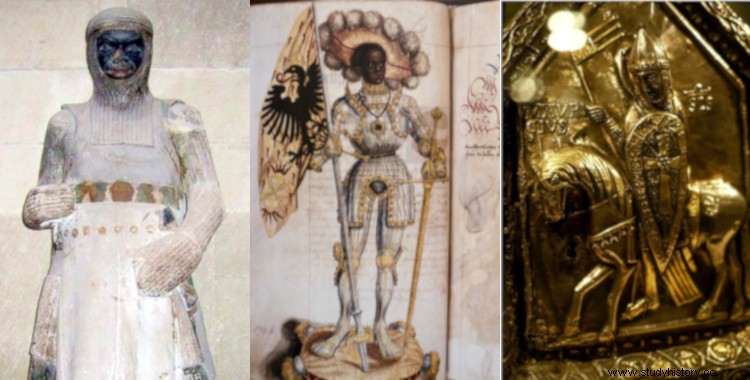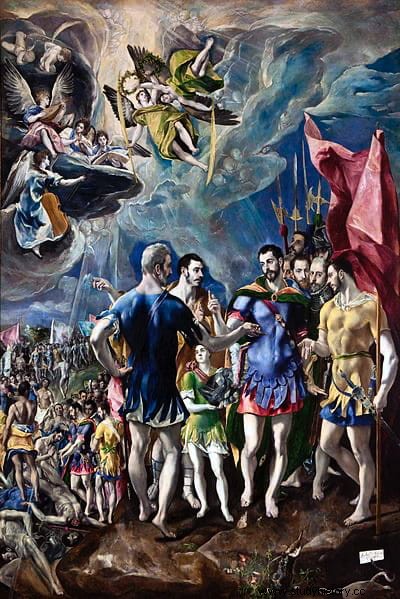If someone plans to visit the German city of Magdeburg, they will inevitably have in mind to enter the cathedral. In this case, we recommend that you go to the tomb of Otto I the Great e, where you will discover an unusual statue:a medieval knight, with his sword at his belt, his coat of mail, his coif and his surcoat, but with the surprising peculiarity of being black.
It is not a politically correct work but rather a representation of Saint Maurice, patron saint of the Holy Roman Empire (whose crown Otto wore for eleven years, in the 10th century). He was an Egyptian-Roman officer of the Theban Legion, decimated, according to tradition, by Diocletian for refusing to fight the Christians.
Evidently, the Mauritian iconography is based on the conventionalism of emphasizing the African origin of the saint, even though in Egypt sub-Saharans are a minority and, in any case, more common in the extreme south, near Sudan (there came from the XXV dynasty, the Kushita, whose pharaohs were black).

In the middle of the 3rd century AD, when the Roman Empire ruled the country, Diocletian created a province there called Thebaid, which comprised the thirteen southern nomes between Abydos and Aswan. As its territory was mostly desert, many Christian hermits chose that place to settle and characters such as San Antonio Abad or, later, Pacomio made the religion of Christ take root.
The case of Pacomio is especially timely because he was a Roman soldier, a native of Thebes, who was part of Maxentius's side in the civil war for the throne that pitted him against Constantine. Since he was recruited by force, he was lucky to never see combat and would later leave military life to become a hermit, promoter of monasticism in the Thebaid. Mauricio had a similar beginning; he was also a Theban, although he was born three decades earlier, around 250 A.D., and like him he entered the army but voluntarily, to develop a military career.

At that time, the Romans had two garrisons in the Thebaid, corresponding to the Legio I Maximiana and to the Legio II Flavia Constantia , both created by Diocletian as comitatenses , that is, mobile troops without a fixed headquarters. However, Christian hagiographies, which are the only documentary source, say that Mauricio would have joined the Theban Legion , whose identification is confusing.
The French nineteenth-century historian Amédée Thierry believes that it was organized by merging various bodies of the armies of the East, such as the Legio XXII Deiotariana , founded in 48 B.C. and scrapped sometime in the first half of the 2nd century AD. because the last reference to it was in 119 AD. and twenty-six years later it does not appear in the list of Roman military forces.
The fact is that the Deiotariana was stationed in Thebes before being sent to Aelia Capitolina (present-day Jerusalem) to suppress the rebellion of Simon bar Kokhba, a Jewish leader who proclaimed himself Nasi (prince) in Hadrian's time, before he was defeated in 135 AD. It is possible that the legion suffered so many casualties that it was decided to join the survivors with other units. But it is also true that it was not about her because another 19th century historian, Charles Robert, did a study in which he identified two legions made up of Thebans, the III Diocletiana Thebaeorum and the already cited I Maximiana Thebaeorum , whose creators were, as can be deduced from his names, the emperor Diocletian and his Caesar Maximian (in reality they formed a third, the I Jovia Foelix Thebaeorum ).

In short, it is a mystery on which the experts do not agree but whatever it was, if we go back to the classic story, at least four of its officers converted to Christianity under the influence of Bishop Hymenaeus and promised before Pope Gaius to disobey any imperial order against your new faith. Gaius, the twenty-eighth pontiff, had the ironic peculiarity of being Diocletian's nephew, so he was supposed to be well-informed enough to confirm the rumor that his uncle was planning to start a campaign against the Bagauda rebellion in Gaul, which was already under way. fighting Caesar (co-emperor) Maximiano, hence Mauricio, Inocencio, Exuperio and Cándido, the officers in question, were reluctant to obey.
The bagaudas were a series of gangs made up of a strange mixture of bandits, revolutionaries, deserters, escaped slaves, ruined peasants and indigents who tried to survive through looting, although the movement was acquiring more complex overtones with political, social and economic issues. , demanding autonomy, tax reductions and legal amnesties. The problem was not only in their survival over time (they emerged towards the last quarter of the 3rd century AD and would continue for seven more) but in their extension to other territories and the fact that some barbarian peoples saw in them an opportunity to challenge to Rome, allying. That is why Diocletian considered them a risk important enough to send none other than a Caesar, Maximian, to suppress them in the year 285 AD.

And so he was about to send reinforcement troops now, the choice falling on the Theban Legion , transferred ad hoc to Gaul. Its legionnaires - sometimes numbered six thousand six hundred and sixty-six to resemble the number of the Biblical Beast - had garrisoned themselves in Agaunum (now a Swiss village in the canton of Valais, renamed Saint Maurice in honor of the saint) and received order to mobilize to clear of enemies what is now known as the Great St. Bernard Pass, a route to cross the Alps.
But, as was the custom in the Roman world, before setting off they had to participate in a religious ceremony, paying homage to the gods and swearing allegiance to the emperor. And it so happened that most, if not all, of the men were Coptic Christians who were obviously repelled by the idea of worshiping pagan deities.
The troops refused and Maximian, enraged, ordered a decimatio , a punishment so extraordinarily harsh that it was often considered counterproductive, hence it was reserved for cases of exceptional gravity. It consisted of dividing each cohort into groups of a dozen soldiers and executing one of each by lot, with the aggravating circumstance that the executioners had to be their own companions, the nine who had escaped, who then had to spend the night outside the protection of the palisade of the castrum . The sentence was carried out by stoning or caning and did not exclude officers.

Bearing in mind that there were ten cohorts in the legions and each of these was made up of just under half a thousand men, the decimatio it turned out terrible; or exemplary, which is what I intended. But things would be even worse, because the other legionnaires insisted on refusing and Maximiano ordered the total annihilation of the legion. It must be deduced that the Caesar would have other forces or it would be impossible to put it into practice, but the truth is that this story should not be taken literally because it is considered more legend than anything else.
The decimatio it was so rare that the last one of which there is reliable information was applied by Galba two centuries earlier and the fact that a legion was made up entirely of Christians - who were also not inclined to serve in the army - sounds unbelievable.
The key is in the sources. The main one is a letter that Saint Eucherius, bishop of Lyons, addressed to another bishop, Savio, in the middle of the fourth century, and that some scholars consider a mere literary expression of a local tradition, since no reference to that episode appears in the time when it allegedly occurred, despite the fact that at first it would seem quite important.
Perhaps it was not the entire legion but only a detachment and that is why the name of the four officers mentioned (all canonized) has come to light, but the fact is that, according to Euquerio, their bodies were found five decades earlier by Theodolus, the first bishop of Octudurum, where he built a basilica with the aim of attracting pilgrims.
The pilgrimage was a very good reason to find deceased saints, since it was a considerable incentive to regional trade and brought the locality renown and rich donations; in fact, in the sixth century, the Burgundian king Sigismund gave land and financed the construction of an abbey there, remains of which still remain.
Around the same time, the Gallo-Roman historian Gregory of Tours reviewed the miraculous character of the relics of the saints, although transferring the facts to Cologne (this story is also a tradition in the Rhineland and for a long time it was believed that the skulls found in the crypt of the basilica of San Paulino belonged to the dead legionnaires, although we now know that they correspond to a Roman necropolis on which the temple was erected).
In this way, the echo grew and the history of the Theban Legion was incorporated into Christian historiography; even John Foxe included him in his anti-Catholic propaganda martyrology.

However, alternative historicist versions emerged in which most of the legionnaires managed to escape (Saint Victor of Marseilles, for example, who would end up crushed to death by refusing to abjure), as reflected by the monk Otto of Freising in the twelfth century, or in which it is interpreted that the decimatio was confused of a single cohort for that of the entire legion.
Nor should we forget that Diocletian carried out a harsh religious persecution that between the years 284 and 299 focused on purging the army of Christians; precisely the rites of worship to the emperor were the tool used to unmask them. On the other hand, the archaeological record has brought to light coins and documents that would coincide with the presence of a Theban Legion in or around Agaunum.
The fact is that the history of Saint Maurice and his pious legionnaires has served as a juicy theme for art, since we not only have the statue from the tomb of Otto but also a multitude of works from the Middle Ages onwards, by the hand of artists such as Matthias Grünewald, Rómulo Cincinato, Jean Hey, Lucas Craanach the Elder , Jan de Herdt, Bernini, Titian, Francesco Zugno, El Greco…
